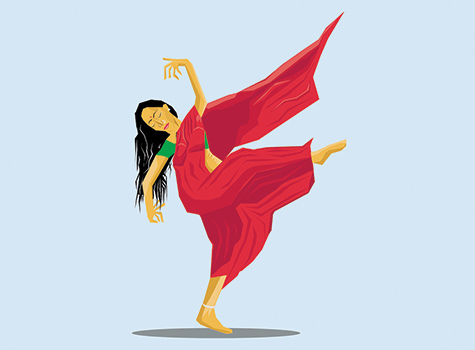By Preethi Sriram

I am an adult Indian dance student, and the concept of age can come into play at various junctures. At what age is a good age to start dance? When doing a quick online search on what age to start Bharatanatyam, the first answer that shows up in the search is the age of six. After an average of 7-8 years of instruction and practice, the student may be eligible for an Arangetram at the age of 14. That may be the most well-known traditional path, but it is interesting to see a different trend in dance in general. For instance, what about those who were not initially put in dance at the age of six, or they may have stopped dance in between and want to pick up the dance form again. At what age then would be a good time to start the dance?
This seems to be a less well-defined area and a newer path that is being created in society from its prior iterations. Also, with globalization, and the topics of diversity, equity and inclusion being subjects of focus, people are reassessing traditional norms and paradigms that may have been held. In the arts, this is something that also is being reassessed. Specifically, in dance, who can be considered a “dancer?” Should the dancer have a certain look? What sort of physical abilities should the dancer have? In a traditional paradigm, we may think “Oh the dancer should be fit” or the “dancer should be able to hear and see” or the “dancer should not have two left feet” or “oh the dancer should be of this background for this style of dance” and so forth. But then there are those who challenge these paradigms and help us to see the world differently.
For instance, in an article in the Times of India, a teacher of dance, notes that very few people realize that she had low vision. As a student, she had to forgo her chemistry course and instead took an academic course in Bharatanatyam, and then earned a diploma for teaching dance. The teacher notes how she is proud of being the first visually impaired person to take up dancing. In a post by “TheBetterIndia” a young girl who started dancing at the age of five, and then lost her left leg at the age of 11, could have decided to stop dancing, but she was shown Naache Mayuri, a movie about Sudha Chandran who had lost her leg, and the girl decided to continue her dream of dancing. It notes in the post, that a year after her initial surgery, she picked up her ghungroos and started to dance again.
In a different article by “TheBetterIndia”, Hussain runs a dance academy called “We Are One” where the students are all Persons with a Disability (PWD). Hussain notes that at a young, he had a high fever that left him wheelchair bound. Hussain describes that at the Amar Jyoti Charitable Trust where he attended school, dance came into his life; at the age of 12, he was able to perform in a dance that he describes as an awakening for him.
He remarks that the journey for him in dance was not an easy one and describes that as he comes from a Muslim background, his family could not understand his desire to learn Bharatanatyam. He mentions that he did not start in the dance to prove any points, but mainly because it brought him joy.
The dance academy not only performed Bharatanatyam, but also to Salsa, Manipuri and martial dances, as well as yoga on wheels.
This leads to the topic of age. If paradigms are being shifted with regards to abilities and backgrounds, what about age? How “avant garde” can we get in this construct?
I attended a show by the Rainbow Dance Company at Meredith College that was scheduled at the end of March, and really enjoyed the show. On the website Artstogether.org/rainbow, the Rainbow Dance Co is the innovation of Lemma Mackie who is also the Arts Together founder, and it is described as the only multi-age modern dance company in North Carolina.
The company has members from ages 10 through 60 plus, where the members explore various societal topics through dance and they participate uniquely.
For example, a 10-year-old has the courage to provide artistic critique to their elders where both can respect each other as peers.
This is a direct contrast in paradigms to traditional thoughts in society where children are expected to listen to adults, and where conflicts can be seen between generations (i.e. generation X vs, generation Y, versus generation Z and so forth). This model in the Rainbow Dance Co is a constructive method of teaching how different ages need to work together and respect each other as individuals, versus stereotyping them by their ages.
People also have notions of how different people of different ages should be and act. Sometimes a kid who may be wise, may seem older than this age. For instance, a child who may be precocious and loves to learn, may be told by someone older to “Go outside and play.”
I have heard a child in a class say something so wise, that some may wonder how such a young child had such a deep awareness. Or we think that certain activities are limited to certain ages.
This leads to an interesting Indian movie that is on Netflix called KD. In the movie, it explores the happenstance friendship between an elder man and a young child. The movie itself could be considered quirky, and an “indie” film, which are the type of films I enjoy. It explores the deeper messages of who we are as people. For instance, are we defined by societies’ expectations of who we should be, or should that journey of who we are be defined by ourselves? What path should we follow and is one path suitable for everyone? Or can a new path be forged?
As a society, as artists, as dancers, and as individuals, these are questions that may not have one answer or one solution.
The past may have some answers, or the present may have some answers, or we may need to search for the answers. But when there is not a clear path in place, or when it is time to reevaluate current norms and thinking, or when we just want to have fun and try something new, challenging the status quo may create the required changes in society.
If you are contemplating what is the best time to start something, the present is the gift.
This series of articles is about the journey and unique insights of an adult dance student learning classical Indian dance and the experiences and perspective of taking classical Indian dance as both an American and an Indian.
Preethi Sriram is a classical dance enthusiast and lifelong learner of dance. Contact: [email protected]



